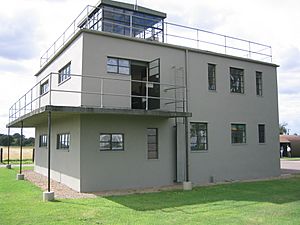100th Bomb Group Memorial Museum facts for kids

The Control Tower now forms part the 100th Bomb Group Memorial Museum
|
|
| Location | Common Road, Dickleburgh, Diss, Norfolk, IP21 4PH, |
|---|---|
The 100th Bomb Group Memorial Museum is a special place in Norfolk, England. It's located near the town of Diss, on what used to be an old airfield called RAF Thorpe Abbotts. This museum is named after the 100th Bomb Group, a group of brave American soldiers who flew planes during World War II.
The museum honors all the American airmen from the US 8th Air Force who helped the Allies fight in Norfolk during the war. Because so many Americans were stationed there, the area even earned a nickname: "Fields of Little America."
Discover the 100th Bomb Group Museum
This museum helps visitors understand what life was like for these soldiers. It shows how they lived and worked during a very important time in history.
What You'll See Inside
The museum is set up in the original control tower and other buildings from the old airfield. Inside the control tower, you can explore different exhibits. You'll find old documents, photographs, and uniforms that the soldiers wore. There's also service equipment they used. You can even see a recreated teleprinter room, which was used for sending messages.
The museum also has maps and other items from World War II. These items help tell the story of the soldiers. You'll learn why the 100th Bomb Group eventually became known as the "Bloody Hundredth." This nickname came from the very difficult and dangerous missions they flew.
The Control Tower's Story
The very top of the control tower is called the "glasshouse." From here, you can still see parts of the old airstrips where planes took off and landed. The glasshouse looks much like it did when the airfield was busy during the 1940s. There's even a model of the airbase from that time, showing how everything was laid out.

